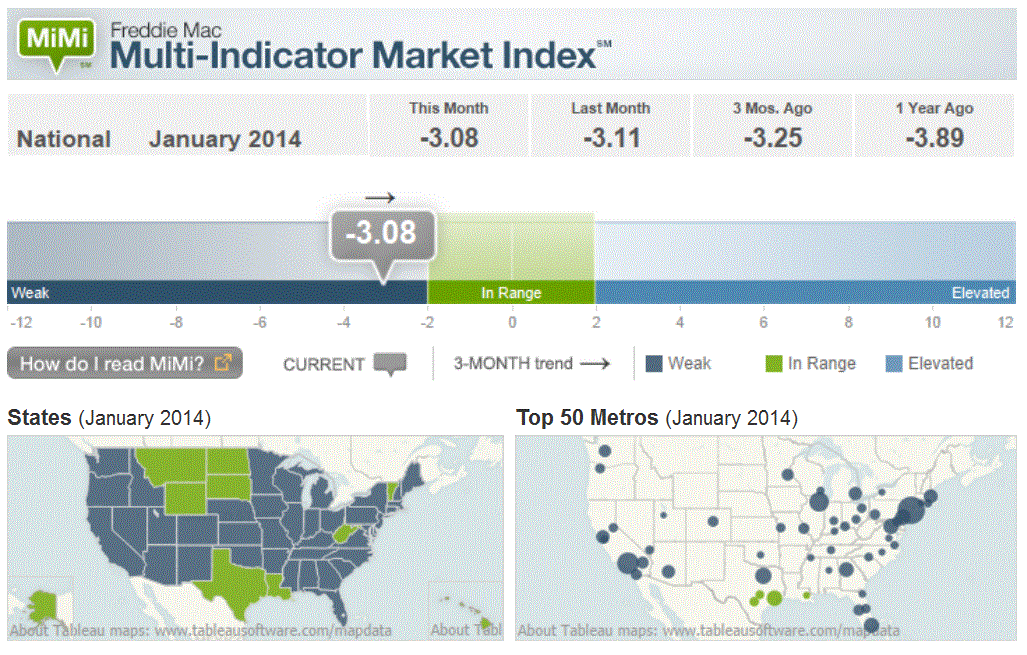Blog

For Housing, a New Definition of 'Normal,' and a New Index to Track it
Freddie Mac and its economists wouldrnlike to answer the old question “are we there yet?” with “there” in this casernmeaning anywhere close to a normal housing market. Asrnpart of that goal, the company today premiered a new tool, the Freddie Mac Multi-Indicator Market Index (MiMi). This newrnpublicly-accessible tool monitors and measures the stability of the nation’srnhousing market, as well as the housing markets of all 50 states, the Districtrnof Columbia, and the top 50 metro markets.</p
MiMi uses proprietary Freddie Macrndata, combining it with information on local markets in order to calculate arnrange of equilibrium for each single-family market tracked. The user will be able to see at a glancernwhere each market stands relative to its stable range and where each market isrntrending in relation to that range – is it falling away by failing to generaternenough demand to balance the market or by overheating to an unsustainable level.</p
Freddie Mac’s Chief Economist FrankrnE. Nothaft said it has been more than seven years since the beginning of therndeepest housing recession since the Great Depression and the nervousrnspeculation about when, if ever, housing would get back too normal. “Givenrnthe pickup in sales, new construction, and home values over the past couple ofrnyears, it’s fair to ask if we’re there yet: is the U.S. housing market back torna normal range of activity with a good balance between demand and supplyrnforces?”</p
“MiMi is the right housingrnindex at the right time as we once again transition to a purchase-dominated</bhousing market," Nothaft said. "With recent history demonstrating thatrnhousing activity differs substantially from market to market, MiMi offers a freshrnperspective on housing at the local level just as we are entering this newrnpurchase market landscape. MiMi helps to pinpoint each market's 'sweet spot' byrnfocusing on local housing differences while also tracking the fundamentalsrnnecessary for a stable market. MiMi draws from multiple data sources –rnincluding Freddie Mac proprietary data generated through our daily businessrnwith more than 2,000 mortgage lenders across the country — to create currentrninsights into how the housing market at the national, state, and local level isrntrending."</p
Data used by MiMi to assess whererneach market is relative to its own long-term stable range includes homernpurchase applications, payment-to-income ratios (which allows measurement of changesrnin home purchasing power), proportion of on time mortgage payments, and thernlocal employment picture. The four indicators are combined to create arncomposite MiMi value for each market.</p
Nothaft said that housing is clearlyrnstronger today than at any point since the Great Recession began with homernsales up 13 percent from the 2009 trough, housing starts up 55 percent, andrnserious delinquencies down 32 percent. rnThe unemployment rate has dropped nearly three percentage points, “thoughrnat a stubbornly slow pace.” But he asks, “Has the market recovered, is itrnstill recovering, or (as some claim) is it overheating into a new bubble?”</p
Developing MiMi meant reviewing thernvarious definitions of a “normal” housing market. The economists rejected definitions peggingrnnormal to the peak of the last market as too vague, since peaks are inherentlyrnunstable, and unhelpful from a responsible business perspective, using instead currentrnand historic data to define a “normal” market as one where there is arnstable range of housing activity. They then used this stable definition for eachrnmarket to create an index which can measure, monitor, and graphically showrnwhere each is today in relation to their stable ranges and recent past.</p
 </p
</p
Today’s inaugural index highlightsrnseveral key findings about the current state of the national’s housing marketrnas of this past January.</p<ul class="unIndentedList"<liThe national MiMi is -3.08 pointsrnwhich indicates a weak housing market overall. This is an increase of 0.03 point fromrnDecember to January and 0.81points from one year ago. The nation's housingrnmarket is improving based on its 3-month trend of +0.17 points and movingrncloser to its stable and in range status. The nation's all-time MiMi low ofrn-4.49 was in November 2010 when the housing market was at its weakest. </li<liEleven of the 50 states plus thernDistrict of Columbia are stable and in range.rnNorth Dakota, the District of Columbia, Wyoming, Alaska, and Louisianarnrank as the top five. </li</ul<ul type="disc"
Freddie Mac Deputy Chief EconomistrnLen Kiefer said the first MiMi illustrates some themes for the nation’srnimproving housing markets. Many show arnbetter employment picture along with some income growth making it possible forrnmore people to buy a home while staying within reasonable debt-income ratios onrntheir mortgages. “But some high costrnmarkets are already starting to feel an affordability pinch,” he said, while atrnthe same time, “those markets with a strong energy-related presence are postingrnsolid house price gains supported by employment and wage growth. Conversely,rnmany markets are still in recovery mode with ground to make up.” Kiefer said that only four of the 50 metrornareas tracked by MiMi are in range with this issue, but 35 are improving and asrnthe spring homebuying season rolls out, “we hope to see recent trends continuernwith more markets moving closer to their long-term stable range.”
All Content Copyright © 2003 – 2009 Brown House Media, Inc. All Rights Reserved.nReproduction in any form without permission of MortgageNewsDaily.com is prohibited.
Latest Articles
By John Gittelsohn August 24, 2020, 4:00 AM PDT Some of the largest real estate investors are walking away from Read More...
Late-Stage Delinquencies are SurgingAug 21 2020, 11:59AM Like the report from Black Knight earlier today, the second quarter National Delinquency Survey from the Read More...
Published by the Federal Reserve Bank of San FranciscoIt was recently published by the Federal Reserve Bank of San Francisco, which is about as official as you can Read More...

Comments
Leave a Comment